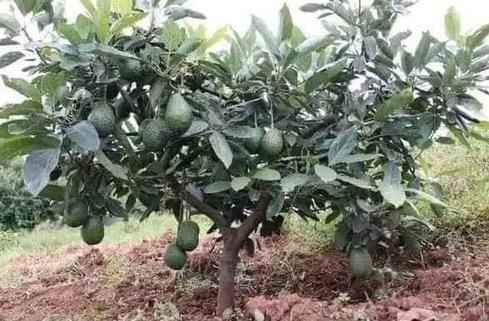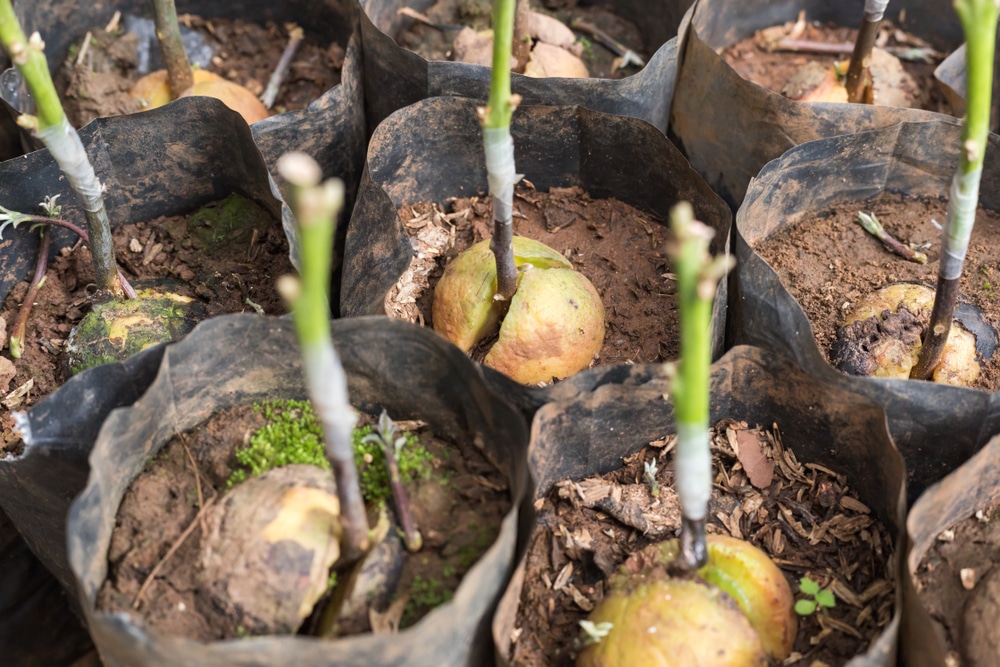
Hass avocado tree is an avocado tree propagated by grafting onto rootstocks that are resistant to Phytophthora root rot, and are tolerant to saline and calcareous soils.
Select healthy egg sized seeds and plant them into 6’ x9’ tins, pots or polythene bags. Water them until they attain a pencil size thickness at which stage they should be grafted.
Hass avocados thrive in subtropical or tropical climates but can also be grown successfully in cooler areas of the world. The optimum temperature for growing hass avocado tree is between 25 and 33°C with moderate humidity levels.
Once established, trees can tolerate temperatures down to around -2°C with minimal damage but young trees will not tolerate freezing temperatures.
It requires a well draining, aerated soil and produce a shallow root system which require a warm soil for efficient water and nutrient uptake.
Although trees will tolerate low rainfall, irrigation, particularly during flowering and fruit set, will ensure high fruit yields.
Grafted Hass avocado tree seedlings have the following advantages:-
- Come into bearing 3 years earlier than un grafted ones.
- Spread out as compared to un grafted ones, which tend to grow upright.
- They are shorter and thus easier to harvest or spray.
- They maintain the desirable characteristics of the mother plant e.g. fruit quality.
Orchard establishment of hass avocado trees
Dig holes 60cm x 60 cm x 60 cm (length x width x depth).
Mix 30 kg of decomposed manure and120 g of TSP with the topsoil.
Fill the hole with the mixture.
Carefully remove the plant from the container with the soil intact and place it at the center of the hole and firm the soil around the plant.
Water the plant immediately after planting.
Fertilization
Soil analysis to determine the type and rate of fertilizer to be applied must be done before any fertilizer use recommendation is given.
Quantity of manure and fertilizer application is dependent on the fertility status of your soil and the age of the tree.
Nitrogen is the controlling factor of avocado yields.
At the onset of each long and each short rains remove mulch and scatter manure and fertilizer
Pruning Hass avocado tree
Do formative pruning in hass avocadoes to shape the tree.
Growing tips of young plants are pinched to promote a more compact tree.
Remove lower branches if they interfere with irrigation or general field hygiene.
Do not prune too severely because the tree is very susceptible to sun burn.
However, remove internal branches and dead twigs.
Heavy pruning is only used to reduce the size of the tree after many years of growth.
Diseases and pests
- Anthracnose Glomerella cingulata. Chlorotic and necrotic spots, dead leaf tip; defoliation, brown or purple lesions on new shoots. Control; prune dead twigs and branches from tree before fungi produce spores; knock dead leaves out of canopy; keep harvested fruit dry and cool
- Scab Sphaceloma perseae ;Oval or irregular brown or purple spots on fruit with rough texture. Control; Plant tolerant varieties; spray with copper containing fungicides
- Stem-end rot; Shriveled tissue at stem end, dark brown or black lesions at stem end and eventually over entire fruit; caused by fungus Management; Prune dead limbs and twigs; prune and harvest in dry conditions; provide trees with sufficient irrigation; apply a thick layer of mulch
4.Bacterial soft rot: Causes a dark, stinking rot on the fruit. Once contracted, the disease cannot be cured.
Management; Source certified seedlings from a reputable nursery
5.Wilts and blights – They are characterized by dead areas in trees, when only a part of the tree is affected.
These cause sudden wilting of leaves and death of branches. Pruning the symptomatic tissues from trees
and providing good support can help your avocado recover.
Pests include; Spider mites, Insect borers, Thrips, Lace bugs, False codling moth, Scales and Fruit flies
Finally
If this information is of help to you, kindly share with others or leave a comment
Happy harvest!!!
